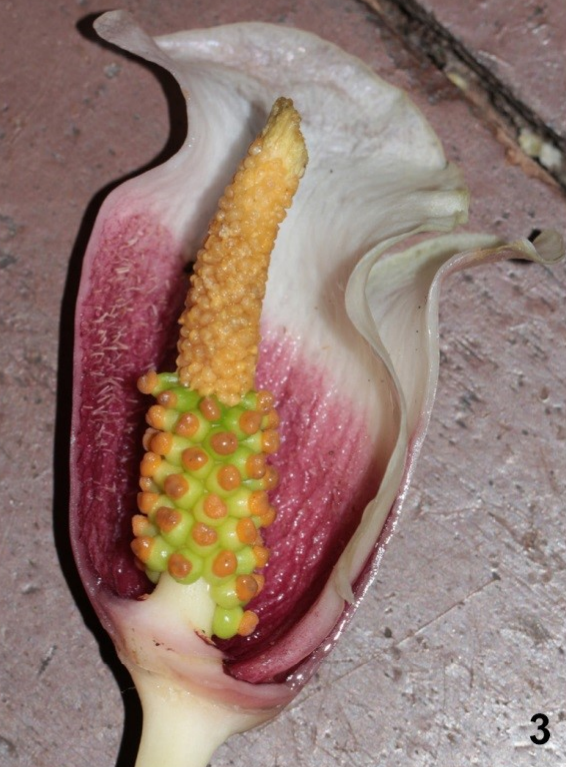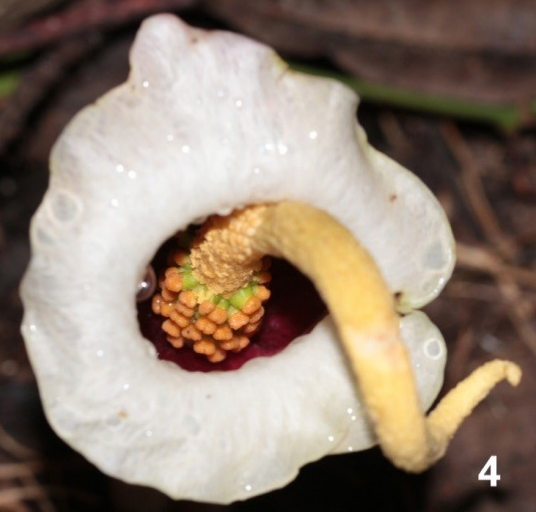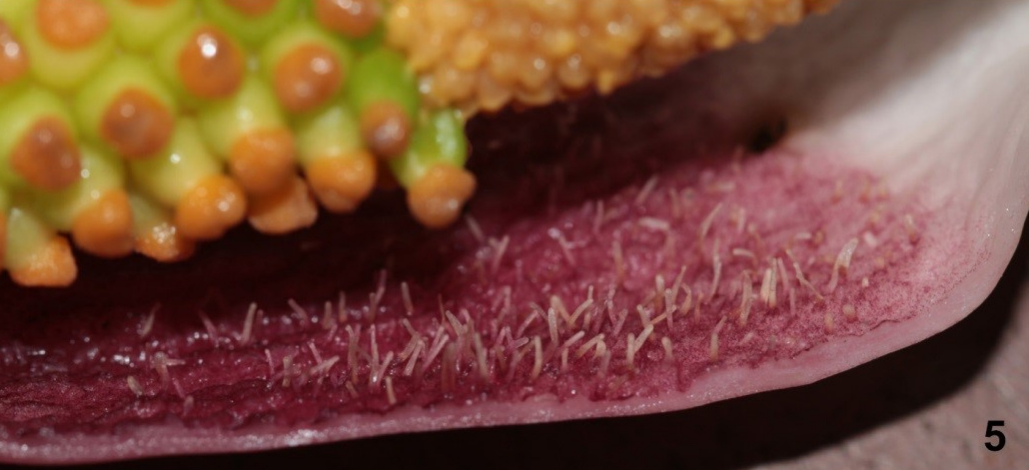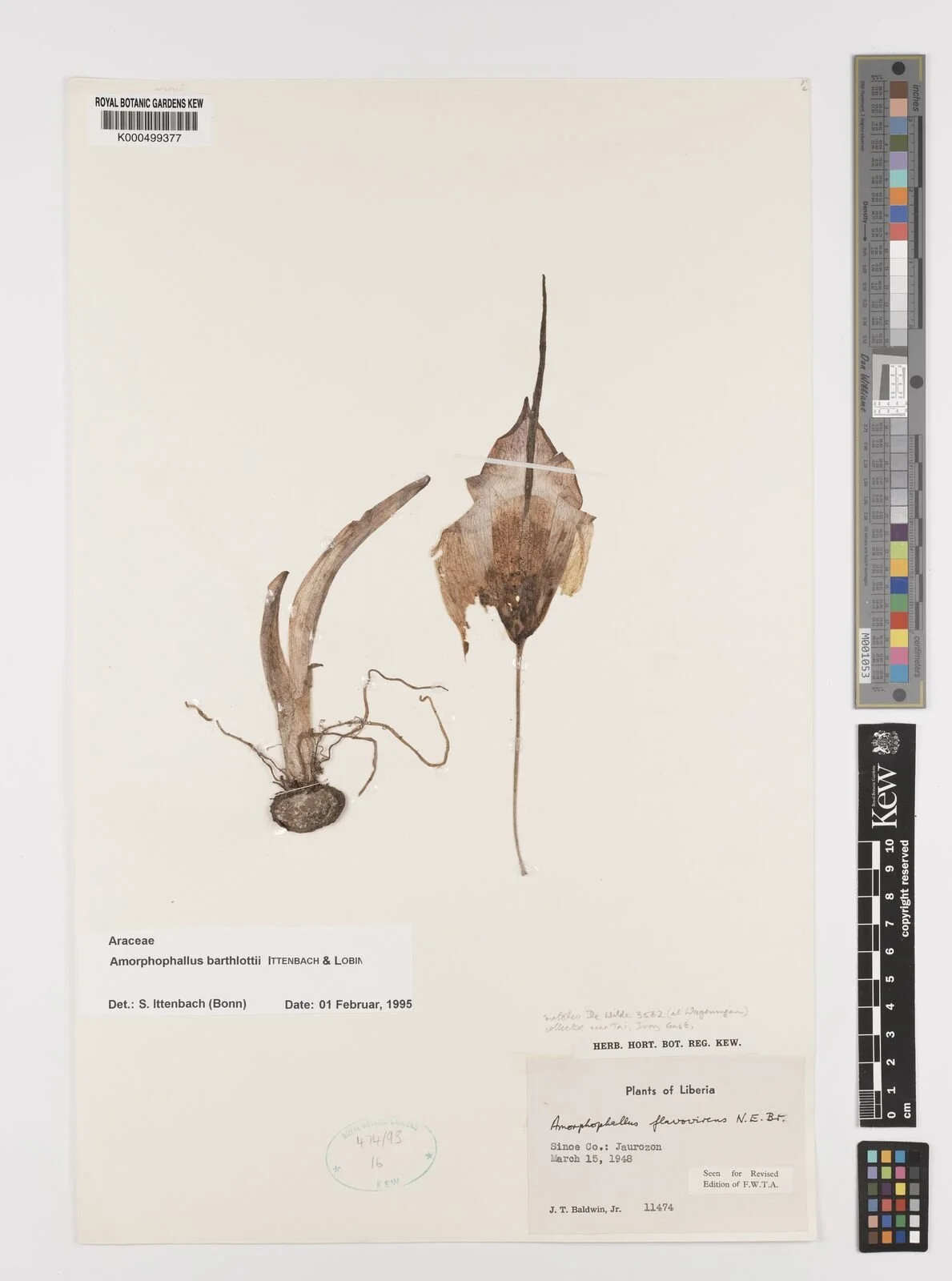AMORPHOPHALLUS BARTHLOTTII
ORIGINAL DESCRIPTION:
Amorphophallus barthlottii Ittenb. & Lobin, sp. nova
Differt ab Amorphophallo staudtii spatha vasiforme, margine spathae cortinam solum per partes cingens et in laminam triangularem terminans; facies interior spathae basim cum emergentiis brevioribus (<1 mm longis) laxe distributis. Pars staminata inflorescentiae cylindrica. Ab A. johnsonii differt inflorescentia valde minore.
TYPE: Ivory Coast, Tai, Regenwald entlang Hana, 100 m, 9.3.1977, Barthlott 77−443 (FR! [inflo.]) [= Amorphophallus staudtii sensu Barthlott & Bogner in Aroideana 4(4): 109. 1981, non (Engl.) N.E. Br.].
Photo by Chanon Limtaropas
SYNONYMS:
HOMOTYPIC SYNONYMS: N/A
HETEROTYPIC SYNONYMS: N/A
ACCEPTED INFRASPECIFICS: N/A
DISTRIBUTION: Ivory Coast, East Liberia | Tai National Park and borderland
CLIMATE: N/A
ECOLOGY:
SPECIES DESCRIPTION:
Tuber globose or subglobose, 2−4 7 1.5−3 cm, surface whitish, probably not developing offsets. Leaf unknown. Cataphylls 3, 4−13 cm long, membranous, whitish to green with a touch of pink, the inner one longer than the peduncle.
INFLORESCENCE:
Inflorescence short-peduncled, appearing before the leaf; peduncle 5−9 cm long, half of it subterranean, 1.5−3 mm in diameter, smooth. Spathe erect, forming a conical bag 7−9 cm long and 3.5−4 cm in diameter, tube and limb separated by a shallow constriction; tube oblong-triangular in lateral view, 3.5−5.5 7 2.5−3.5 cm, cross section shape circular, outside whitish to dirty pinkish or greenish, inside purple to purplish brown, with very short (0.4−0.9 mm) loosely dispersed hairlike emergences, surface between emergences rough to papillose, unicoloured dark purple, veins somewhat raised; limb erect, 3−4 cm long, triangular-acute, inside and outside whitish to dirty pinkish, margin smooth to undulate and flushed with purple. Spadix stipitate for 1−3 mm, 8−13 cm long, slightly longer than spathe (1 : 0.7−0.9); pistillate zone cylindrical, 1−1.5 cm long, 4−5 mm in diameter, flowers congested or slightly distant; staminate zone cylindrical, 1.3−2 mm long, 2.5−3.5 mm in diameter, flowers congested; appendix elongate-conical, acute, 5−9 cm long, base without constriction, equal in diameter to the staminate zone, surface rough to rugulose; ratio of pistillate to staminate zone length 0.7−0.8 : 1; staminodes absent; without sterile zone between staminate and pistillate zone. Staminate flowers 1−1.5 mm long, with 2−4 stamens; filaments only 0.5 mm long, free; anthers free, elongate to ovoid; thecae ovoid, yellow, each with one apical circular pore. Pistillate flowers 3−3.5 mm long; ovaries globose to ovoid, 2 mm long and wide, green or greenish white, bilocular; stigma sessile, slightly 2-lobed, 1.5−2 mm in diameter, 1 mm long, circular in cross section. Infructescence unknown. Pollen globular, inaperturate, c. 50 μm in diameter, exine smooth (psilate).
VARIEGATED FORMS: N/A
ETYMOLOGY: The species is dedicated to the German botanist Prof. Dr Wilhelm Barthlott (Bonn), who has been concerned with the flora of the Ivory Coast since 1976 and collected the type specimen in 1977.
NOTES:
Amorphophallus barthlottii is one of the smallest species in the genus and certainly the smallest of the African species. It was erroneously identified as Amorphophallus staudtii (Engl.) N.E. Br. by Barthlott & Bogner (1981). Amorphophallus barthlottii belongs to a group of species with a limited distribution in the very humid part of Liberia and the Ivory Coast. It has to be placed into the large African section with hairlike emergences at the base of the spathe tube, and is similar to Amorphophallus johnsonii, Amorphophallus calabaricus, Amorphophallus zenkeri and Amorphophallus staudtii.
Amorphophallus barthlottii is believed to be pollinated by nocturnal beetles, particularly members of the Onthophagini tribe (Scarabaeidae), a group of coprophagous (dung-feeding) beetles. This association suggests that Amorphophallus barthlottii likely emits a scent bouquet mimicking decaying organic matter, similar to that of Amorphophallus abyssinicus, which attracts both copro- and necrophagous beetles. While the exact chemical composition of Amorphophallus barthlottii’s floral odor remains unknown, its effectiveness in attracting these beetles implies a shared evolutionary adaptation toward deceptive pollination strategies. The species is thought to flower at night, aligning with the activity period of its beetle pollinators. In contrast, Amorphophallus abyssinicus appears to initiate anthesis during the day, potentially reflecting differing ecological pressures and pollinator behaviors. Both species utilize a trapping mechanism similar to that seen in Arisaema, featuring a constricted, slippery inner spathe surface lined with papillae and coated in cuticular waxes that inhibit insect escape. In Amorphophallus barthlottii, this is further supported by the presence of glandular hairs producing a yellow resin. These adaptations ensure temporary retention of pollinators within the floral chamber to facilitate effective pollen transfer. Interestingly, the pollen exine in Amorphophallus barthlottii is psilate (smooth), consistent with most species in the subgenus Afrophallus and believed to be optimized for beetle-mediated pollination. In contrast, Amorphophallus abyssinicus subsp. akeassii has verrucate (warted) pollen, an unusual trait within the genus and more often associated with dipteran (fly) pollination. Unlike many Asian Amorphophallus species, African taxa such as Amorphophallus barthlottii lack sterile flowers or staminodes, suggesting that visual and olfactory mimicry alone is sufficient to ensure pollinator attraction and retention.
Additional specimens seen Ivory Coast: Regenwald zwischen Troya und dem Fluß Cavally, c. 32 km SSO vom Tai, auf der Straße Tai-Tabou, 8.3.1962, De Wilde 3562 (WAG). Liberia: Sinoe Country, Jaurozon, 15.3.1948, Baldwin Jr. 11474 (K).
CULTIVARS: N/A
HYBRIDS: N/A











